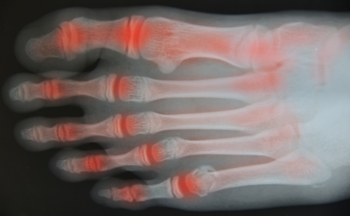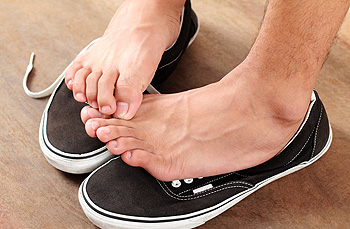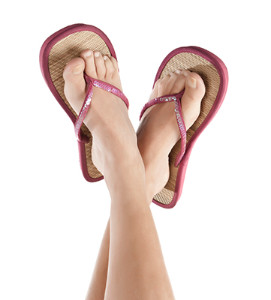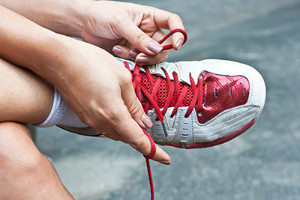Joint replacement surgery remo ves damaged or diseased parts of a joint and replaces them with new, man-made ones. Replacing joints can reduce pain and help you move and feel better. Joints usually will need to be repaired when they are damaged from arthritis, overuse, and sometimes disease. After a person has completed the surgery, they are typically required to undergo physical therapy as soon as possible to help strengthen the muscles around the joint and to regain motion in the joint. If you believe you have damaged or diseased joints in the feet or ankles, it is important to consult with a podiatrist.
ves damaged or diseased parts of a joint and replaces them with new, man-made ones. Replacing joints can reduce pain and help you move and feel better. Joints usually will need to be repaired when they are damaged from arthritis, overuse, and sometimes disease. After a person has completed the surgery, they are typically required to undergo physical therapy as soon as possible to help strengthen the muscles around the joint and to regain motion in the joint. If you believe you have damaged or diseased joints in the feet or ankles, it is important to consult with a podiatrist.
In certain cases, in which the patient suffers from extreme pain or damage in a joint, joint replacement surgery may be deemed useful. If you have constant pain in a foot joint, consult with Dr. Richard DiMario from Maine. Our doctor will assess your condition and provide you with quality foot and ankle treatment.
What Is Joint Replacement Surgery?
Over time, joints wear down; this can be exacerbated by diseases and conditions. Joint replacement surgery, also known as arthroplasty, is when a damaged joint is surgically removed and replaced with a prosthesis. Prostheses, which can be made of ceramic, plastic, or metal, act as joints in lieu of an actual joint. One of the most prevalent causes for joint replacement is arthritis.
Arthritis in the Foot
Arthritis can occur in any joint in the body, including in the feet. Common types of arthritis in the foot are osteoarthritis, rheumatoid arthritis, and gout. The big toe is usually where arthritis occurs in the foot; this is known as hallux rigidus.
Joint Replacement Surgery in the Foot
The most common form of joint replacement in the foot is a first metatarsophalangeal (MTP) joint placement. MTP joint replacement surgery is designed to treat hallux rigidus. Surgery is not intensive, and recovery occurs within one to two months after the procedure has been done. Overall, joint replacement surgery is a safe and effective way to treat pain in the joint of the foot.
If you have any questions, please feel free to contact our office located in York, ME . We offer the newest diagnostic and treatment technologies for all your foot care needs.
 Plantar hyperhidrosis is the condition of excessive feet sweating. Hyperhidrosis can be extremely uncomfortable. There are a few measures to take in order to prevent uncontrolled sweating. One method is to log when sweating episodes occur. You may begin to notice that you sweat more when you are in specific situations or eat certain types of foods. Also, be sure to wear the correct socks. You should have different socks for the seasons and for various types of athletic activities. In addition to having the correct socks, choose shoes that are made of lightweight fabrics, such as canvas or leather. Another method is to use antifungal powder or cornstarch on your feet. You may want to apply an antiperspirant to the feet once or twice per week, as well. Finally, stay hydrated. Proper hydration can reduce sweating throughout the whole body. If you believe you may be experiencing plantar hyperhidrosis, be sure to contact a podiatrist who can help treat the affliction.
Plantar hyperhidrosis is the condition of excessive feet sweating. Hyperhidrosis can be extremely uncomfortable. There are a few measures to take in order to prevent uncontrolled sweating. One method is to log when sweating episodes occur. You may begin to notice that you sweat more when you are in specific situations or eat certain types of foods. Also, be sure to wear the correct socks. You should have different socks for the seasons and for various types of athletic activities. In addition to having the correct socks, choose shoes that are made of lightweight fabrics, such as canvas or leather. Another method is to use antifungal powder or cornstarch on your feet. You may want to apply an antiperspirant to the feet once or twice per week, as well. Finally, stay hydrated. Proper hydration can reduce sweating throughout the whole body. If you believe you may be experiencing plantar hyperhidrosis, be sure to contact a podiatrist who can help treat the affliction.
If you are suffering from hyperhidrosis contact Dr. Richard DiMario of Maine. Our doctor can provide the care you need to attend to all of your foot and ankle needs.
Hyperhidrosis of the Feet
Hyperhidrosis is a rare disorder that can cause people to have excessive sweating of their feet. This can usually occur all on its own without rigorous activity involved. People who suffer from hyperhidrosis may also experience sweaty palms.
Although it is said that sweating is a healthy process meant to cool down the body temperature and to maintain a proper internal temperature, hyperhidrosis may prove to be a huge hindrance on a person’s everyday life.
Plantar hyperhidrosis is considered to be the main form of hyperhidrosis. Secondary hyperhidrosis can refer to sweating that occurs in areas other than the feet or hands and armpits. Often this may be a sign of it being related to another medical condition such as menopause, hyperthyroidism and even Parkinson’s disease.
In order to alleviate this condition, it is important to see your doctor so that they may prescribe the necessary medications so that you can begin to live a normal life again. If this is left untreated, it is said that it will persist throughout an individual’s life.
A last resort approach would be surgery, but it is best to speak with your doctor to find out what may be the best treatment for you.
If you have any questions please feel free to contact our office located in York, ME . We offer the newest diagnostic and treatment technologies for all your foot and ankle needs.
 Many people enjoy the simplicity of wearing flip flops. They are easy to slip into, which makes them a desirable shoe to wear. Despite their popularity, research has indicated they can be harmful to the feet. The arch is typically absent in this type of shoe, which may cause pain in the feet and ankles. Additionally, flip flops lack shock absorption, and there is minimal cushioning in the heel area. Many people also have to curl their toes which helps to provide stability in these shoes, and this may change the way you walk. It is beneficial wear shoes that have a strap on the back, which aids in supporting the foot. If you would like additional information about how flip flops affect the feet, it is suggested that you consult with a podiatrist.
Many people enjoy the simplicity of wearing flip flops. They are easy to slip into, which makes them a desirable shoe to wear. Despite their popularity, research has indicated they can be harmful to the feet. The arch is typically absent in this type of shoe, which may cause pain in the feet and ankles. Additionally, flip flops lack shock absorption, and there is minimal cushioning in the heel area. Many people also have to curl their toes which helps to provide stability in these shoes, and this may change the way you walk. It is beneficial wear shoes that have a strap on the back, which aids in supporting the foot. If you would like additional information about how flip flops affect the feet, it is suggested that you consult with a podiatrist.
Flip-flops can cause a lot of problems for your feet. If you have any concerns about your feet or ankles, contact Dr. Richard DiMario from Maine. Our doctor will assist you with all of your foot and ankle needs.
Flip-Flops and Feet
Flip-flops have managed to become a summer essential for a lot of people. While the shoes may be stylish and easy to slip on and off, they can be dangerous to those who wear them too often. These shoes might protect you from fungal infections such as athlete’s foot, but they can also give you foot pain and sprained ankles if you trip while wearing them.
When Are They Okay to Wear?
Flip-flops should only be worn for very short periods of time. They can help protect your feet in places that are crawling with fungi, such as gym locker rooms. Athlete’s foot and plantar warts are two common fungi that flip-flops may help protect your feet against.
Why Are They Bad for My Feet?
These shoes do not offer any arch support, so they are not ideal for everyday use. They also do not provide shock absorption or heel cushioning which can be problematic for your feet. Additionally, you may suffer from glass cuts, puncture wounds, and stubbed toes since they offer little protection for your feet.
More Reasons Why They Are Bad for Your Feet
If you have any questions, please feel free to contact our office located in York, ME . We offer the newest diagnostic and treatment technologies for all your foot care needs.
 The majority of people who enjoy the sport of running often choose shoes that are flexible. The flexibility is generally unnecessary in walking shoes, and these shoes are designed with materials that are stiff. There are different types of running shoes to choose from, and this will often depend on the type of running that is performed. People who run for speed may find shoes that have minimal cushioning can be beneficial in achieving their running goals. Additionally, long distance runners may prefer shoes that have maximum support. If you are pursuing running as a hobby, it is advised to counsel with a podiatrist who can guide you in determining which type of running shoe is best for you.
The majority of people who enjoy the sport of running often choose shoes that are flexible. The flexibility is generally unnecessary in walking shoes, and these shoes are designed with materials that are stiff. There are different types of running shoes to choose from, and this will often depend on the type of running that is performed. People who run for speed may find shoes that have minimal cushioning can be beneficial in achieving their running goals. Additionally, long distance runners may prefer shoes that have maximum support. If you are pursuing running as a hobby, it is advised to counsel with a podiatrist who can guide you in determining which type of running shoe is best for you.
For more information about walking shoes versus running shoes, consult with Dr. Richard DiMario from Maine. Our doctor can measure your feet to determine what your needs are and help you find an appropriate pair of footwear.
Foot Health: The Differences between Walking & Running Shoes
There are great ways to stay in shape: running and walking are two great exercises to a healthy lifestyle. It is important to know that running shoes and walking shoes are not interchangeable. There is a key difference on how the feet hit the ground when someone is running or walking. This is why one should be aware that a shoe is designed differently for each activity.
You may be asking yourself what the real differences are between walking and running shoes and the answers may shock you.
Differences
Walking doesn’t involve as much stress or impact on the feet as running does. However, this doesn’t mean that you should be any less prepared. When you’re walking, you land on your heels and have your foot roll forward. This rolling motion requires additional support to the feet.
Flexibility – Walking shoes are designed to have soft, flexible soles. This allows the walker to push off easily with each step.
If you have any questions, please feel free to contact our office located in York, ME . We offer the newest diagnostic and treatment technologies for all your foot care needs.